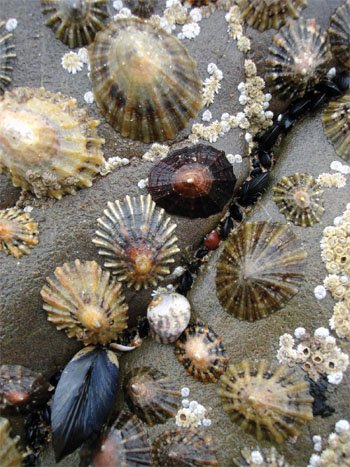Common Limpet
The shape of the limpet varies. The closer the limpet is to the water, the flatter and smaller its shell.
Design

The shape of the limpet varies. The closer the limpet is to the water, the flatter and smaller its shell. The farther the limpet is from the water, the wider and taller its shell. This design is an adaptation that God programmed into the species’ DNA for survival. Without this adaptation, the waves would beat against and be more likely to pull away a tall, wide limpet close to the water. This is an example of adaptation, not evolution.
Features
- The common limpet has a cone-like shell that protects it from predators and from the environment.
- The limpet travels across the rocks by contracting its single foot.
- Its shell is gray to dirty white, often with yellow to red markings. The interior of the shell is gray-green.
Fun Facts
- The limpet travels across the rocks to find food, but it has a certain spot that it has ground into the rock as its anchor spot. When the limpet moves from this spot, it leaves a trail of mucus to follow back to its anchor spot.
- It is found on exposed coastlines as well as quiet bays.
- This species is moderately territorial, showing some aggression toward other individuals of the same species.
CLASS: Gastropoda (gastropods, slugs, and snails)
ORDER: Patellogastropoda (limpets)
FAMILY: Patellidae (marine limpets)
GENUS/SPECIES: Patella vulgata
Size: Up to 2.4 in (6 cm) in diameter
Diet: Algae, diatoms, and blue-green algae
Habitat: Rocks on shores of Northeastern Atlantic coast, from the Arctic Circle
to Portugal
Aquarium Guide
With fun facts about more than 100 animals, this long-awaited Aquarium Guide includes beautiful pictures and reveals the incredible facts and design features that point to our amazing Creator. This handy size guide is excellent for school field trips and family trips to your favorite aquarium!
Browse Kids Book- © 2024 Answers in Genesis
- Privacy Policy
- Contact
- About

